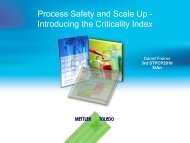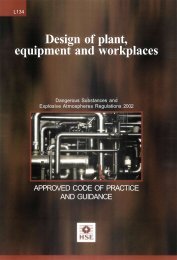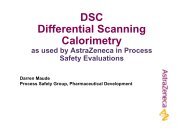Designing and operating safe chemical reaction processes HSG143
Designing and operating safe chemical reaction processes HSG143
Designing and operating safe chemical reaction processes HSG143
Create successful ePaper yourself
Turn your PDF publications into a flip-book with our unique Google optimized e-Paper software.
Health <strong>and</strong> SafetyExecutiveInitial assessments63 Research chemists <strong>and</strong> other research <strong>and</strong> development professionals playa fundamental role in the development of a <strong>safe</strong> process. They must make anin-depth investigation into the process chemistry <strong>and</strong> into the entire processthat may develop based on that chemistry. These professionals have manyopportunities to incorporate inherently <strong>safe</strong>r design concepts. For example,they can choose inherently <strong>safe</strong>r synthesis routes. See Appendix 2 for furtherinformation.Literature surveys64 The initial assessment you can carry out at this early stage involves a desktopstudy of the potential reactants <strong>and</strong> routes to a given product. A literature search ofthe <strong>chemical</strong>s to be used <strong>and</strong> the process chemistry can be useful, if it is thorough.65 Bretherick’s H<strong>and</strong>book of reactive <strong>chemical</strong> hazards 22 <strong>and</strong> the National FireProtection Association’s Manual of hazardous <strong>chemical</strong> <strong>reaction</strong>s 23 are useful texts.They give accounts of numerous previous incidents with many surprising <strong>and</strong>unexpected exothermic runaway <strong>reaction</strong>s. However, the absence of particularinformation does not imply that no hazards exist.66 It is at this early stage that you can consider inherently <strong>safe</strong>r synthesis routes.Examples of synthesis routes considered inherently <strong>safe</strong>r include:(a) Avoiding highly exothermic <strong>reaction</strong>s or thermally unstable reactants <strong>and</strong>intermediates.(b) Replacement of batch <strong>reaction</strong> <strong>processes</strong> with semi-batch or continuous<strong>processes</strong>. This reduces the quantity of reactant present <strong>and</strong> controlling theaddition rate may stop the <strong>reaction</strong> in the event of a hazard arising (seeparagraphs 131-135 on controlling <strong>reaction</strong> rates).(c) Reactions in water as opposed to those which proceed in a more hazardousorganic solvent (provided water is compatible with the <strong>reaction</strong> mixture).(d) The use of <strong>processes</strong> which are less sensitive to variations in <strong>operating</strong>conditions, especially those defined as critical such as temperature or pressure.(e) Supercritical processing uses relatively non-hazardous materials such as wateror carbon dioxide as solvents, albeit at high temperatures <strong>and</strong> pressures.(f) The use of catalysts which can lead to less severe <strong>operating</strong> conditions, allowthe use of a less reactive reagent or the opportunity to reduce or eliminatea hazardous solvent.(g) Use of solvents to act as a heat sink. The addition of a higher boiling pointsolvent may prevent the <strong>reaction</strong> mass boiling <strong>and</strong> overpressurising thereactor. Alternatively, in some <strong>processes</strong> the use of lower boiling point solventsallows the removal of energy from the system in the form of latent heat ofvaporisation. You need to take care when selecting either of these options. Forexample, the solvent boiling point should be below any temperature at which adecomposition <strong>reaction</strong> can occur; <strong>and</strong> with low boiling point solvents, the heatcapacity of the <strong>reaction</strong> mass should be such that evaporation to drynesscannot occur.<strong>Designing</strong> <strong>and</strong> <strong>operating</strong> <strong>safe</strong> <strong>chemical</strong> <strong>reaction</strong> <strong>processes</strong> Page 16 of 64










